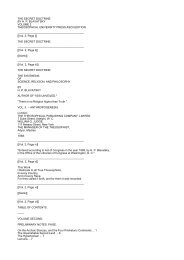You also want an ePaper? Increase the reach of your titles
YUMPU automatically turns print PDFs into web optimized ePapers that Google loves.
The Abode Of The Blessed.<br />
The souls <strong>of</strong> <strong>the</strong> dead made <strong>the</strong>ir way to <strong>the</strong>ir abode in <strong>the</strong> "o<strong>the</strong>r world" by a ladder, according to a very<br />
ancient view, or through a gap in <strong>the</strong> mountains <strong>of</strong> Abydos called Peka according to ano<strong>the</strong>r; but, by<br />
whichever way <strong>the</strong>y passed from earth, <strong>the</strong>ir destination was a region in <strong>the</strong> Tuat which is called in <strong>the</strong><br />
pyramid and later texts Sekhet-Aaru,[7] which was situated in <strong>the</strong><br />
[1. Brugsch, op. cit., p. 211.<br />
2. The legend reads "This is Nut, she receiveth Ra."<br />
3. ###.<br />
4. Wörterbuch, p. 1622.<br />
5. Lanzone, Domicile des Esprits, p. 1; Dizionario, p. 1292.<br />
6. Maspero, La Mythologie Égyptienne (Études, I. ii., p. 207); Jéquier, Le Livre, p. 3 The eastern mountain peak was called<br />
Bakhatet, and <strong>the</strong> western Manu.<br />
7. I.e., <strong>the</strong> Field <strong>of</strong> reed plants.]<br />
{p. cv}<br />
The Fields <strong>of</strong> Aaru and Hetep.<br />
Sekhet-Hetep,[l] and was supposed to lie to <strong>the</strong> north <strong>of</strong> Egypt. Here dwell Horus and Set, for <strong>the</strong> fields<br />
<strong>of</strong> Aaru and Hetep are <strong>the</strong>ir domains,[2] and here enters <strong>the</strong> deceased with two <strong>of</strong> <strong>the</strong> children <strong>of</strong> Horus<br />
on one side <strong>of</strong> him, and two on <strong>the</strong> o<strong>the</strong>r,[3] and <strong>the</strong> "two great chiefs who preside over <strong>the</strong> throne <strong>of</strong> <strong>the</strong><br />
great god proclaim eternal life and power for him."[4] Here like <strong>the</strong> supreme God he is declared to be<br />
"one," and <strong>the</strong> four children <strong>of</strong> Horus proclaim his name to Ra. Having gone to <strong>the</strong> north <strong>of</strong> <strong>the</strong> Aaru<br />
Field he makes his way to <strong>the</strong> eastern portion <strong>of</strong> <strong>the</strong> tuat, where according to one legend he becomes like<br />
<strong>the</strong> morning star, near[6] his sister Sothis.[7] Here he lived in <strong>the</strong> form <strong>of</strong> <strong>the</strong> star Sothis, and "<strong>the</strong> great<br />
and little companies <strong>of</strong> <strong>the</strong> gods purify him in <strong>the</strong> Great Bear." The Egyptian <strong>the</strong>ologians, who conceived<br />
that a ladder was necessary to enable <strong>the</strong> soul to ascend to <strong>the</strong> next world, provided it also with an<br />
address which it was to utter when it reached <strong>the</strong> top. As given in <strong>the</strong> pyramid <strong>of</strong> Unas it reads as<br />
follows':--"Hail to <strong>the</strong>e, O daughter <strong>of</strong> Amenta, mistress <strong>of</strong> Peteru(?) <strong>of</strong> heaven, thou gift <strong>of</strong> Thoth, thou<br />
mistress <strong>of</strong> <strong>the</strong> two sides <strong>of</strong> <strong>the</strong> ladder, open a way to Unas, let Unas pass. Hail to <strong>the</strong>e, O Nau, who art<br />
[seated] upon <strong>the</strong> brink <strong>of</strong> <strong>the</strong> Lake <strong>of</strong> Kha, open thou a way to Unas, let Unas pass. Hail to <strong>the</strong>e, O thou<br />
bull <strong>of</strong> four horns, thou who hast one horn to <strong>the</strong> west, and one to <strong>the</strong> east, and one to <strong>the</strong> north, and one<br />
to <strong>the</strong> south, . . . . . . let Unas pass, for he is a being from <strong>the</strong> purified Amenta, who goeth forth from <strong>the</strong><br />
country <strong>of</strong> Baqta. Hail to <strong>the</strong>e, O Sekhet-Hetep, hail to <strong>the</strong>e, and to <strong>the</strong> fields which are in <strong>the</strong>e, <strong>the</strong> fields<br />
<strong>of</strong> Unas are in <strong>the</strong>e, for pure <strong>of</strong>ferings are in <strong>the</strong>e."<br />
[1. I.e., <strong>the</strong> Field <strong>of</strong> Peace.<br />
2. Recueil de Travaux, t. v., p. 191 (l. 182).<br />
3. Ibid., p. 50 (l. 262).<br />
4. Ibid., t. vii., p. 163 (1. 402).<br />
5. Ibid., t. iv., p. 49. (l. 432).<br />
6. Ibid., t. v., p. 186 (ll. 80, 170, 177).<br />
http://www.sacred-texts.com/egy/ebod/ebod08.htm (3 <strong>of</strong> 4) [8/10/2001 11:23:43 AM]

















